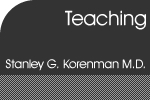

|
<< Previous Section | < Previous Page | Next Page > | Next Section >>
Bibliography (page 4 of 13) Campbell, E. G., J. S. Weissman, et al. (2001). "Market Competition and Patient-oriented Research: The Results of a National Survey of Medical School Faculty." Acad Med 76(11): 1119-1126. They tried to determine the impact of carrying out clinical care in a competitive environment on research productivity by surveying research faculty (2336 responses). They found that both basic and clinical research productivity was adversely affected by the need to do more clinical care in the most competitive markets. Good study demonstrating the impact of changing priorities for survival. Cech, T. and J. Leonard (2001). "Science and business. Conflicts of interest--moving beyond disclosure." Science 291(5506): 989. As director of the Howard Hughes Institute the author makes his point about conflicts of interest in research and indicates a strong position in avoiding them. Cho, M., R. Shohara, et al. (2000). "Policies on faculty conflicts of interest at US universities." JAMA 284(17): 2203-8. This excellent study has become somewhat dated because of the impacts of studies and changing policies secondary to various forces acting on universities. It reviewed COI policies of 89/100 polled Institutions. They found that there was great variability in types of relationships that were controlled, the financial limits, and the disclosures required. They recommended much more specific and consistent rules throughout the country. Coyle, S. L. (2002). "Physician-Industry Relations. Part 1: Individual Physicians." Ann Intern Med 136(5): 396-402. This is part 1 of a 2-part paper on ethics in physician-industry relationships. Part 1 offers advice to individual physicians; gives recommendations to medical education providers and medical professional societies. While physicians and commerce share an interest in advancing medical knowledge they diverge in that the former is a fiduciary for the patient and the latter has responsibility primarily toward its investors. This can lead to conflicts of interest, biased reporting and issues with appropriate experimental design. While physicians and trainees think they are impervious to Drug Company blandishments, the companies know better. So physicians have to decide for themselves what gifts raise no problems and which do. A general guideline is inexpensive and no strings attached. But, in our society, the very act of accepting a gift creates an obligation. Other financial ties between physicians and industry include honorariums for speaking or writing and payment for doing clinical research. These also can influence a physician's beliefs and practices. The paper goes into considerable detail. Coyle, S. L. (2002). "Physician-Industry Relations. Part 2: Organizational Issues." Ann Intern Med 136(5): 403-406. This is part 2 of a 2-part paper on ethics and physician-industry relationsips. Part 1 offers advice to individual physicians; part 2 considers medical education providers and medical professional societies. While industry develops advances in medicine it also plays a key role in disseminating up-to-date medical information. The problem is bias and providers of the education must protect against that bias by presenting objective and balanced information. To do that, they must be careful of conditions under which money is collected to carry out their programs. They should insist on control of the content and conditions of the learning process Disclosure of industry sponsorship to students, faculty, and continuing medical education trainees is mandatory. This also applies to medical societies. Dana, J and G. Lowenstein (2003). "A social science perspective on gifts to physicians from industry." JAMA 290(2): 252-5. The article uses behavioral science to examine the nature of conflicts of interest. It examines the "self-service bias" in our perceptions of fairness, indicating an individual's notion of fairness is inherently biased toward his/her own self-interest. This makes the article very good in uniting cross-arguments into one inherent principle: human nature. DeAngelis, C., P. Fontanarosa, et al. (2001). "Reporting financial conflicts of interest and relationships between investigators and research sponsors." JAMA 286(1): 89-91. JAMA was one of the first journals to insist on disclosure of COIs in all papers, editorials, etc coming out of their shop. << Previous Section | < Previous Page | Next Page > | Next Section >> |
Chapter 4 Quick Links Conflicts of Interest (COI) Definitions Consequences of a COI Government Intervention Industry Sponsorship Professional Societies Clinical Practice Guidelines Other Initiatives COI in Financial Consulting Cases Bibliography Chapter 4 Download (PDF) |